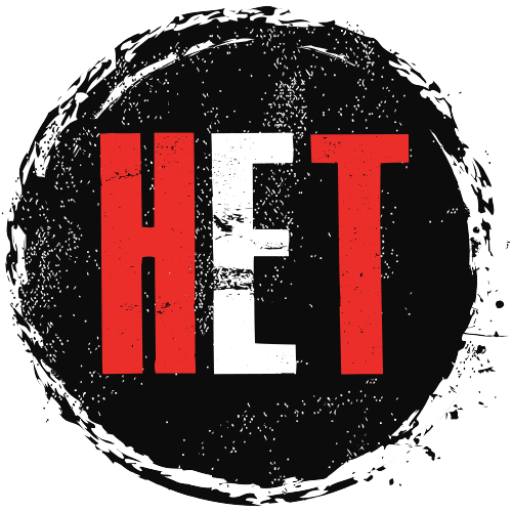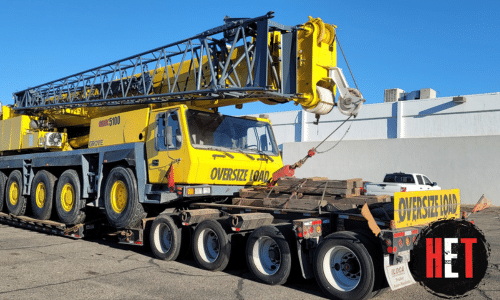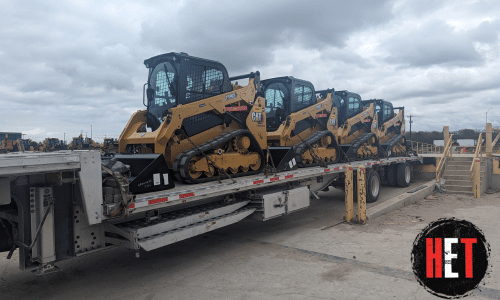Safety Protocols in Heavy Equipment Shipping

William Thomas / January 2021
It is critical to ensure safety while shipping heavy equipment. It is about more than just safeguarding precious machinery; it is also about protecting human lives. Mishandling heavy machinery has serious hazards, ranging from financial losses due to damage to severe personal harm or even death. This emphasizes the crucial importance of strict safety standards. These standards serve as a shield, safeguarding both people and equipment and are required for a safe and effective operation. The seriousness of these threats emphasizes the non-negotiable imperative of following safety regulations in heavy equipment shipment.
The Importance of Proper Heavy Equipment Inspection

“These proactive measures ensure heavy equipment’s safe and efficient movement, reducing downtime, mitigating potential damage, and, most importantly, safeguarding the operators’ and bystanders’ lives.”
Pre-shipment checks are an essential part of guaranteeing heavy equipment shipping safety. They act as an early warning system, detecting possible difficulties before they become significant issues. Inspections cover a wide range of topics, including:
• Checking tire conditions for adequate inflation and wear
• Ensuring lights and brakes are working properly
• Validating the correct weight distribution.
• Confirming the integrity of tie-down points.
This methodical inspection helps to eliminate mishaps, resulting in a safer and more effective heavy equipment transportation process. As a result, these checks are crucial in limiting the dangers connected with heavy equipment shipping.

Transport Your Heavy Equipment Today
Heavy Equipment Transport is always available for a quote. Fill out the form or give us a call now! (888) 730-2951
Understanding The Weight and Size Restrictions of Heavy Equipment Shipping
Heavy loads are classified by weight and size under federal laws, with distinct categories requiring special transportation needs. Because of the potential for damage to road infrastructure or traffic hazards, oversized or overweight equipment frequently necessitates special handling, supplementary permits, and unique vehicle configurations. Large loads, for example, may exceed lane widths, causing traffic congestion, while overweight equipment can damage roads and bridges.
Understanding these classifications and following federal rules is therefore critical in heavy equipment shipping, assuring safety and efficiency while avoiding potential legal consequences and infrastructure damage.
Choosing The Right Trailer to Transport your Heavy Equipment
Choosing the right trailer type for heavy equipment transportation is critical to ensure safe and practical transport. RGN, Step Deck, Double Drop, Flatbed, and Stretch Trailer trailers have unique characteristics and capacities to carry equipment of varying sizes, shapes, and weights.
Matching the trailer to the specifications of the equipment aids in:
• Preventing potential damage during travel
• Increasing load stability
• Promoting compliance with regulatory weight and dimension limits.
This cautious selection assists in limiting transportation risks and optimizing shipping efficiency and thus plays an integral part in the overall success of heavy equipment shipment.
Securing and Protecting Your Equipment in Transport
Heavy equipment must be appropriately secured during transportation to ensure safety. Appropriate securing mechanisms, such as chains, booms, or straps, minimize unwanted movement, lowering the danger of damage or accidents. Furthermore, safeguarding vulnerable portions of the equipment, such as glass components or delicate machinery, is critical to avoiding damage during transit. These safeguards assure regulatory compliance, quick loading and unloading, and the integrity and operating readiness of the equipment.
Adhering to Rules and Regulations When Transporting Heavy Equipment
Heavy equipment transportation needs strict adherence to several federal, state, and local restrictions. These rules, which can differ significantly between locations, govern load size, weight, and transit times.
Noncompliance could result in:
• Severe penalties
• Delays in delivery timeframes
• Damage to one’s reputation
Before transportation, it is critical to obtain the proper permissions, as these validate the legality of the equipment’s size, weight, and route. Compliance with these regulations and licenses ensures a seamless transportation procedure and upholds safety standards, protecting all road users and the transported equipment.

Training and Expertise for Heavy Equipment Transportation
Trained operators are essential for the safe transfer of heavy machinery. Their knowledge prevents damage and ensures on-time delivery. Continuous training and adherence to safety protocols are necessary for operators since:
• Regular training keeps operators up to date on the newest safety regulations and equipment handling techniques, assuring optimal performance and safety
• Up-to-date knowledge assists operators in adhering to changing regulatory criteria and avoiding legal problems.
• Ongoing training improves operator efficiency and lowers the likelihood of accidents, resulting in a safer workplace.
Route Planning for Heavy Equipment Shipping
Planning routes for heavy equipment transportation in advance is beneficial, especially when crossing state or foreign borders. This is due to the following reasons:
• It enables operators to foresee and prevent potential hazards, assuring the safety of the operators and the equipment.
• Foresight is required to navigate the various terrains and weather situations when crossing borders.
• It can assist in avoiding legal difficulties by bypassing regions with tight transportation rules.
• Facilitates on-time customs clearance by choosing routes with fewer logistical constraints.
Preparing for Emergencies When Transporting Heavy Equipment
In the transportation of heavy equipment, emergency planning is critical. It entails developing a comprehensive response strategy, training operators in first aid and crisis management, and outfitting trucks with emergency equipment. A well-thought-out contingency plan lowers downtime, mitigates potential harm, and assures the safety of operators and spectators. In this high-risk industry, it also maintains company continuity. Remember that being prepared is preferable to being caught off guard.
Ensured safety during heavy equipment transportation is a shared duty of all stakeholders. This includes performing extensive equipment inspections, giving obligatory safety training for operators, pre-planning routes to avoid potential hazards, and implementing complete emergency preparedness measures. These proactive measures ensure heavy equipment’s safe and efficient movement, reducing downtime, mitigating potential damage, and, most importantly, safeguarding the operators’ and bystanders’ lives. Safety must be prioritized at all stages of the transportation operation.

William Thomas
Heavy Transport Specialist
Being able to lead a team of such talented logistics agents has been a wonderful experience over the past ten years. If you would like to know anything more about the heavy equipment transport services we offer, don't hesitate to give us a call!